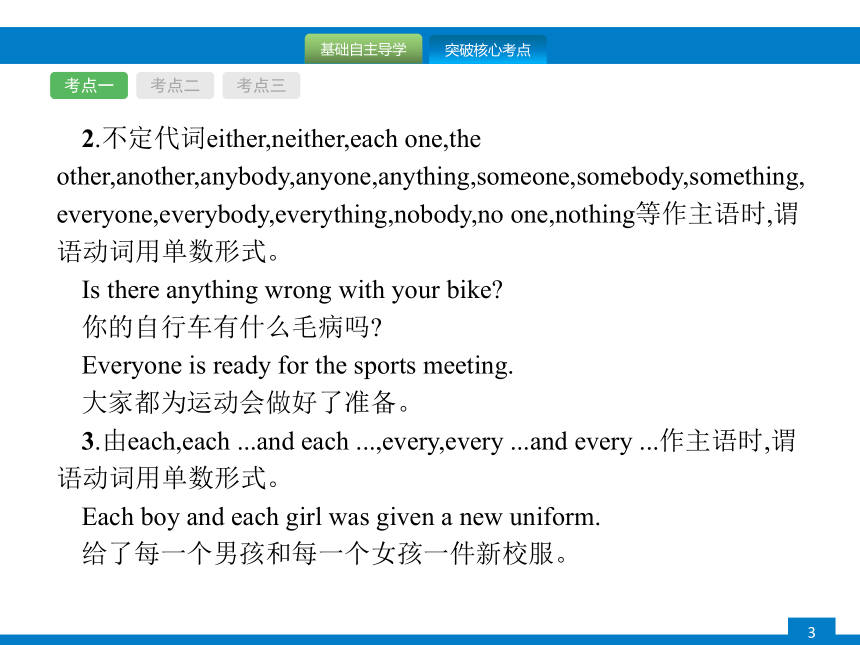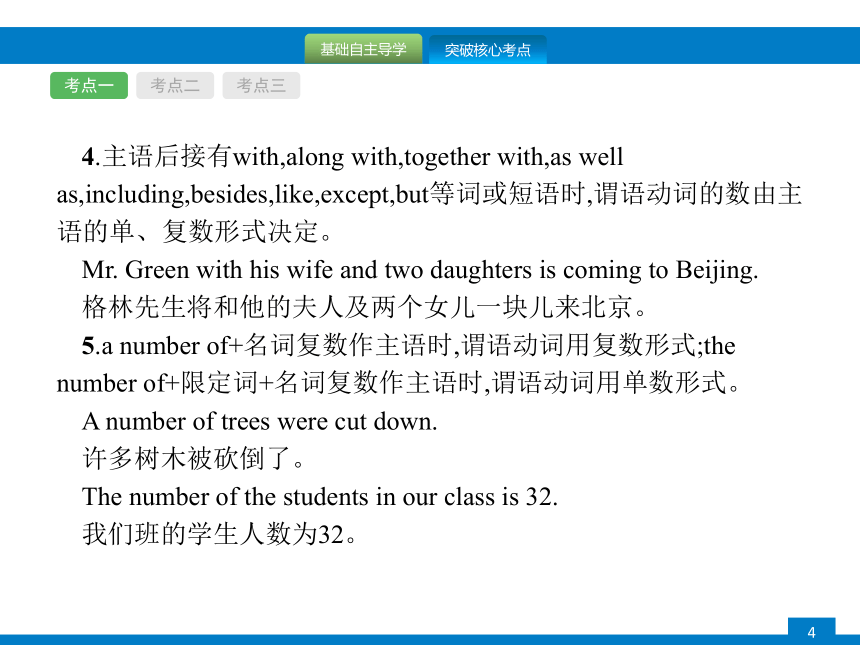2018年中考英语总复习(人教版) 语法专项突破课件:专题十四 主谓一致 (共9张PPT)
文档属性
| 名称 | 2018年中考英语总复习(人教版) 语法专项突破课件:专题十四 主谓一致 (共9张PPT) |  | |
| 格式 | zip | ||
| 文件大小 | 52.9KB | ||
| 资源类型 | 教案 | ||
| 版本资源 | 人教新目标(Go for it)版 | ||
| 科目 | 英语 | ||
| 更新时间 | 2017-10-30 19:34:00 | ||
图片预览




文档简介
课件9张PPT。专题十四 主谓一致考点一考点二考点三主谓一致是指谓语动词和主语在人称和数上保持一致,遵循三个原则:语法一致原则、意义一致原则、就近一致原则。
考点一 语法一致原则 ?
主语和谓语通常是在语法形式上一致,即主语是单数形式时,谓语动词也采用单数形式;主语是复数形式时,谓语动词也采用复数形式。
1.当and或both ...and ...连接两个或两个以上的名词作主语时,谓语动词用复数形式。
Tom and Mike are good friends.汤姆和迈克是好朋友。
Both Lucy and Lily are students.露西和莉莉都是学生。
考点一考点二考点三2.不定代词either,neither,each one,the other,another,anybody,anyone,anything,someone,somebody,something,everyone,everybody,everything,nobody,no one,nothing等作主语时,谓语动词用单数形式。
Is there anything wrong with your bike?
你的自行车有什么毛病吗?
Everyone is ready for the sports meeting.
大家都为运动会做好了准备。
3.由each,each ...and each ...,every,every ...and every ...作主语时,谓语动词用单数形式。
Each boy and each girl was given a new uniform.
给了每一个男孩和每一个女孩一件新校服。考点一考点二考点三4.主语后接有with,along with,together with,as well as,including,besides,like,except,but等词或短语时,谓语动词的数由主语的单、复数形式决定。
Mr. Green with his wife and two daughters is coming to Beijing.
格林先生将和他的夫人及两个女儿一块儿来北京。
5.a number of+名词复数作主语时,谓语动词用复数形式;the number of+限定词+名词复数作主语时,谓语动词用单数形式。
A number of trees were cut down.
许多树木被砍倒了。
The number of the students in our class is 32.
我们班的学生人数为32。考点一考点二考点三6.“a lot of (lots of,plenty of,a pile of,piles of,most of)+名词”和“分数或百分数+名词”等作主语时,谓语动词的单复数取决于名词。如果是不可数名词,则谓语动词用单数形式;如果是可数名词复数,则谓语动词用复数形式。
Lots of people have been there.很多人去过那儿。
7.由“a pair(a kind,a series ...)+of+复数名词”作主语时,谓语动词用单数形式;“pairs(kinds ...)+of+复数名词”作主语时,谓语动词用复数形式。
A pair of sunglasses is lying on the table.
一副太阳镜放在桌子上。
Fifty pairs of shoes are made each day.
每天能制作50双鞋。考点一考点二考点三8.某些只有复数形式的名词(如clothes,trousers,shorts,pants,shoes,gloves ...)作主语时,谓语动词用复数形式。
My glasses were worn out.我的眼镜坏了。
9.不定式或动词-ing形式作主语时,谓语动词用单数形式。
Reading is learning.读书就是学习。
To see is to believe.眼见为实。
考点二 意义一致原则 ?
意义一致又叫概念一致,即谓语动词用单数还是复数要看主语所表达的概念。
1.由and连接的两个名词作主语,如果是指同一概念(即and后面无冠词),则谓语动词用单数形式。
The teacher and writer is coming to give us a talk next week.
那位老师兼作家下周要给我们做报告。
The singer and dancer has been invited to the party.
那位歌唱家兼舞蹈家被邀请参加了晚会。
2.表示金钱、价格、时间、距离、长度等复数名词、词组作主语时,一般被看作一个整体,谓语动词常用单数形式。
Five years is a long time.
五年是一段很长的时间。考点一考点二考点三考点一考点二考点三3.集体名词(如family,team,crowd,company,class,group,government ...)如果表示整体概念,则谓语动词用单数形式,如果表示集体中的成员,则谓语动词用复数形式。
My family are going on vacation next month.
我们一家人下个月要去度假。
My family is a small one with three people.
我家是一个有三口人的小家庭。
4.people,police,cattle等集合名词作主语时,谓语动词用复数形式。
The police are helping a girl find her parents.
警察正在帮助一个女孩找她的父母。
People there are living a happy life.
那儿的人们生活得很快乐。考点一考点二考点三考点三 就近一致原则 ?
有时谓语动词的形式与靠近它的主语一致,这种原则叫作就近一致原则。
1.由either ...or ...,neither ...nor ...,not only ...but (also) ...,not ...but ...或or连接两个并列主语时,谓语动词与较近的主语保持一致。
Not only my parents but also I am looking forward to meeting my uncle.
不只是我父母,我也盼望看到我叔叔。
2.there be ...和here be ...这两个句式中的动词be常与最近的主语在数上保持一致。
There is a table and three chairs in Tom’s room.
在汤姆的房间有一张桌子和三把椅子。
考点一 语法一致原则 ?
主语和谓语通常是在语法形式上一致,即主语是单数形式时,谓语动词也采用单数形式;主语是复数形式时,谓语动词也采用复数形式。
1.当and或both ...and ...连接两个或两个以上的名词作主语时,谓语动词用复数形式。
Tom and Mike are good friends.汤姆和迈克是好朋友。
Both Lucy and Lily are students.露西和莉莉都是学生。
考点一考点二考点三2.不定代词either,neither,each one,the other,another,anybody,anyone,anything,someone,somebody,something,everyone,everybody,everything,nobody,no one,nothing等作主语时,谓语动词用单数形式。
Is there anything wrong with your bike?
你的自行车有什么毛病吗?
Everyone is ready for the sports meeting.
大家都为运动会做好了准备。
3.由each,each ...and each ...,every,every ...and every ...作主语时,谓语动词用单数形式。
Each boy and each girl was given a new uniform.
给了每一个男孩和每一个女孩一件新校服。考点一考点二考点三4.主语后接有with,along with,together with,as well as,including,besides,like,except,but等词或短语时,谓语动词的数由主语的单、复数形式决定。
Mr. Green with his wife and two daughters is coming to Beijing.
格林先生将和他的夫人及两个女儿一块儿来北京。
5.a number of+名词复数作主语时,谓语动词用复数形式;the number of+限定词+名词复数作主语时,谓语动词用单数形式。
A number of trees were cut down.
许多树木被砍倒了。
The number of the students in our class is 32.
我们班的学生人数为32。考点一考点二考点三6.“a lot of (lots of,plenty of,a pile of,piles of,most of)+名词”和“分数或百分数+名词”等作主语时,谓语动词的单复数取决于名词。如果是不可数名词,则谓语动词用单数形式;如果是可数名词复数,则谓语动词用复数形式。
Lots of people have been there.很多人去过那儿。
7.由“a pair(a kind,a series ...)+of+复数名词”作主语时,谓语动词用单数形式;“pairs(kinds ...)+of+复数名词”作主语时,谓语动词用复数形式。
A pair of sunglasses is lying on the table.
一副太阳镜放在桌子上。
Fifty pairs of shoes are made each day.
每天能制作50双鞋。考点一考点二考点三8.某些只有复数形式的名词(如clothes,trousers,shorts,pants,shoes,gloves ...)作主语时,谓语动词用复数形式。
My glasses were worn out.我的眼镜坏了。
9.不定式或动词-ing形式作主语时,谓语动词用单数形式。
Reading is learning.读书就是学习。
To see is to believe.眼见为实。
考点二 意义一致原则 ?
意义一致又叫概念一致,即谓语动词用单数还是复数要看主语所表达的概念。
1.由and连接的两个名词作主语,如果是指同一概念(即and后面无冠词),则谓语动词用单数形式。
The teacher and writer is coming to give us a talk next week.
那位老师兼作家下周要给我们做报告。
The singer and dancer has been invited to the party.
那位歌唱家兼舞蹈家被邀请参加了晚会。
2.表示金钱、价格、时间、距离、长度等复数名词、词组作主语时,一般被看作一个整体,谓语动词常用单数形式。
Five years is a long time.
五年是一段很长的时间。考点一考点二考点三考点一考点二考点三3.集体名词(如family,team,crowd,company,class,group,government ...)如果表示整体概念,则谓语动词用单数形式,如果表示集体中的成员,则谓语动词用复数形式。
My family are going on vacation next month.
我们一家人下个月要去度假。
My family is a small one with three people.
我家是一个有三口人的小家庭。
4.people,police,cattle等集合名词作主语时,谓语动词用复数形式。
The police are helping a girl find her parents.
警察正在帮助一个女孩找她的父母。
People there are living a happy life.
那儿的人们生活得很快乐。考点一考点二考点三考点三 就近一致原则 ?
有时谓语动词的形式与靠近它的主语一致,这种原则叫作就近一致原则。
1.由either ...or ...,neither ...nor ...,not only ...but (also) ...,not ...but ...或or连接两个并列主语时,谓语动词与较近的主语保持一致。
Not only my parents but also I am looking forward to meeting my uncle.
不只是我父母,我也盼望看到我叔叔。
2.there be ...和here be ...这两个句式中的动词be常与最近的主语在数上保持一致。
There is a table and three chairs in Tom’s room.
在汤姆的房间有一张桌子和三把椅子。
同课章节目录
- 词法
- 名词
- 动词和动词短语
- 动词语态
- 动词时态
- 助动词和情态动词
- 非谓语动词
- 冠词
- 代词
- 数词和量词
- 形容词副词及其比较等级
- 介词和介词短语
- 连词和感叹词
- 构词法
- 相似、相近词比较
- 句法
- 陈述句
- 一般疑问句和否定疑问句
- 特殊疑问句及选择疑问句
- 反意疑问句
- 存在句(There be句型)
- 宾语从句
- 定语从句
- 状语从句
- 主谓一致问题
- 简单句
- 并列句
- 复合句
- 主谓一致
- 主、表语从句
- 名词性从句
- 直接引语和间接引语
- 虚拟语气
- 感叹句
- 强调句
- 倒装句
- 祈使句
- 句子的成分
- 句子的分类
- 题型专区
- 单项选择部分
- 易错题
- 完形填空
- 阅读理解
- 词汇练习
- 听说训练
- 句型转换
- 补全对话
- 短文改错
- 翻译
- 书面表达
- 任务型阅读
- 语法填空
- 其他资料
